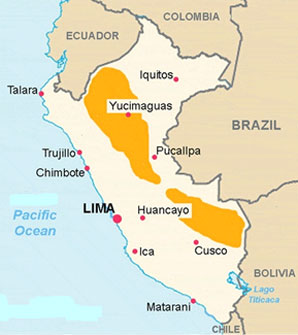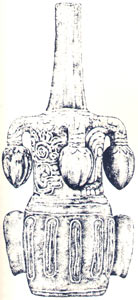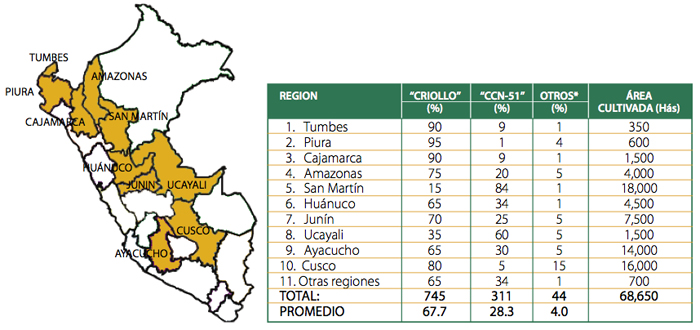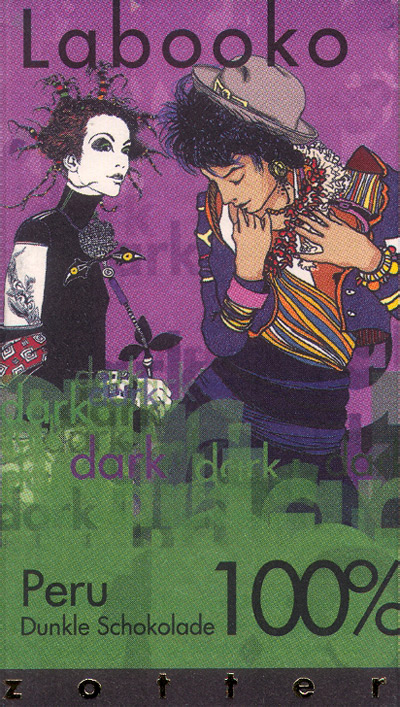 GEN’L FLAVOR: no cocoa powerhouse per se but Fruit & Flowers galore (often soft dried bouquets – wild essences of red banana, papaya, mango + more tropical / jungle fruits & orchids) undercut by Earthen qualities (tobacco, mushroom, & wood); can be quite “green” (climbing vines, vegetative, herbal, etc.); often surly & rambunctious, sturdy & austere due chiefly to uneven post-harvesting (with the exception of customarily drying to relative low moisture content – <6%) but also serene pockets abound to richly reward the keen bean-hunter.
GEN’L FLAVOR: no cocoa powerhouse per se but Fruit & Flowers galore (often soft dried bouquets – wild essences of red banana, papaya, mango + more tropical / jungle fruits & orchids) undercut by Earthen qualities (tobacco, mushroom, & wood); can be quite “green” (climbing vines, vegetative, herbal, etc.); often surly & rambunctious, sturdy & austere due chiefly to uneven post-harvesting (with the exception of customarily drying to relative low moisture content – <6%) but also serene pockets abound to richly reward the keen bean-hunter.
GEN’L CHARACTERISTICS: a mix too complex to hang one label on, in a country that may be the origin of the entire Theobroma cacao species, including Ecuador’s famed Nacional
River systems that intercourse thru what may be the wild cradle of cacáo’s birthplace.

The Incas & their predecessors, the Tiwanaku, habitually chewed leaves from the coca bush Erythroxylum coca (from which the popular drug of power & ego – cocaine – is derived, & not to be confused with cacáo or chocolate) which is native to tropical valleys terraced beneath the high altiplano in the cross-border area of Peru & Bolivia around Lake Titicaca. But just like cacáo, its socio-political force was greater than its physio-chemical effects. It knit those empires together who treated it as a divine plant with spiritual & medicinal properties, often taken by priests for endurance during ritual ceremonies, just as Muslim Sufis drank coffee or Buddhist monks tea. It bore none of the shadowy underworld taint associated with its potent extract among hedonists & workaday consumers around the world. (In fact, the first aboriginal to be elected president of Bolivia, Evo Morales of Aymara descent in 2005, was a coca grower.)
Because Erythroxylum coca’s stimulative effects were readily accessible, Peruvians had little need for Theobroma cacáo’s bitter seeds of which they made only limited & then mostly medicinal use, & perhaps more often with Theobroma bicolor than the Theobroma cacao that produces cocoa & chocolate; certainly nowhere near the extent of Mesoamericans who widely cultivated & revered it. While the written history of cacáo begins in Mesoamerica as early as the 3rd century AD, the first iconography may come from Peru – a 2,500 year-old effigy vessel with pod ornaments. Called the Tembladera ceramic, it hails from the Jequetepeque Valley of northern Peru circa 1100-700BC. It depicts what scholars Nisao Ogata, Arturo Gómez-Pompa, & Karl Taube all argue forcefully are the torpedo-like cacáo pods & a spider monkey excreting probable cacáo seeds (a natural means of dispersal after consuming the pod for its desired fruit pulp, as well as possibly alluding to laxative properties that some indigenous peoples have used it for). Nonetheless, many botanists remain unconvinced that these fruit pods are cacáo, drawing other interpretations that suggest alternatively the melon-shaped pepino dulce, a cocona, or the citrus naranjilla.
Peru is often blanketed by the misguided term “Upper Amazon” (Alto Amazonas) as if everything west of where the Madeira & Negro rivers flow into the Amazon were uniform, when it’s anything but. As explained in the section on Brazil, distinctions between ‘Upper’ & ‘Lower’ Amazon cacáo – whether geographic, genetic, or gastronomic – can be misleading, with a population complex far too diverse & overlapping to draw such a delineation.
Cacáo in this part of the rainforest pulls from 2 geographic centers – the Ucayali & Marañon river valleys – whose confluence become the Amazon River:
1. Rio Ucayali flowing up from the southwest to the northeast – the first recorded contact of Europeans with South American cacáo occurred on lands inhabited by the Chuncho along the Rio Ucayali. Even today, true native cacáo here is often referred to as ‘Cacáo Chuncho’ to distinguish it from varieties introduced more recently.
Early in the 20th century Huber cited extensive & truly wild cacáo in an area that Pound likewise noticed decades later: a central type with distinctly darker green fruit pods, small purple seeds of high moisture content, & a sweet floral pulp. The progenies of what Pound collected here became known as “Scavina”. In 2008, Motamayor classified this central type as the unique varietal Contamana – after the nearby town in which it’s located.
2. Upper Marañon from where the river bends in a more due easterly direction at the confluence with the Chinchipé flowing from Eucuador. Rumors handed down by explorer Charles Marie de La Condamine in 1745 persist about wild cacáo groves around this confluence near the town of Jaén, with native inhabitants valuing it as highly as gold, touting a flavor to match or surpass Eucuador’s original Nacional. Another claim circulates that upstream on the Putumayo toward the Ecuador border, wild Criollo-like trees survive the ‘Putumayo Scandal’ where landowners committed atrocities against local communities who lived & worked there in order to eradicate large swatches of forest to exploit rubber for latex production.
To verify these accounts, a 2009 expedition headed by Enríquez Arévalo of the Tropical Crop Research Institute (ICT) surveyed northern Peru bordering Ecuador – in & around Shuar territory, the tsanta reduction / head shrinkers who’ve turned away from that warrior past by embracing a syncretic faith blending elements of Christianity & traditional beliefs.
Twelve river systems were explored in total. The expedition came across 3 new cacáo populations previously unknown to official science (although nearby inhabitants possibly encountered some on their own forays).
A general common feature they found in ‘Upper Amazon’ cacáo is flush leaves lacking the anthocyanin pigment (that led some to believe in a connection to ancient cacáo [RE: Criollo] from Mesoamerica) which seems at odds for an area that abuts what may be the origin of the Theobroma cacao species where diversity would presumably intensify. Wild trees studied by the expedition in river valleys that form tributaries to the Upper Marañon River include –
Rio Santiago – right below the Andes; reports from 50 or more years ago cite ample diversity with an extremely interesting gradient in variety, in addition to large seed size. Today it all appears less so, though the expedition discovered red-fruiting trees – a Criollo characteristic.
Rio Pastaza – again, where in the past this rather un-navigable artery for travel showed sparse populations with a degree of red pigment & outstandingly large seed size, now has “typical Upper Amazon” cacáo.
Rio Morona – most cacáo trees here exhibit short broad fruit with a length-to-diameter of <2.0; generally rough with ridges / mealy surface &, interestingly, a phenotype similar to Ecuador’s Nacional.
Indeed, the center of Nacional may be from these values, lending credence to the cacáo prospectors at Jaén. During a cacáo rescue & recovery mission in 2009, Dan Pearson of Marañón Canyon Cacao brought to the attention of conservation geneticist Dapeng Zhang & pathologist Lyndel Meinhardt an unusual find: genuine Nacional growing here. Unusual in that Nacional was thought to exist only across the border in Ecuador. This substantiates what La Condamine in 1745, Pound in 1938 & Bartley in 2005 had all previously documented & provides more proof that natural geography trumps national boundaries.
These 2 great rivers – the Ucayali & Marañon – meet just to the west of the town Iquitos along a stretch of the Amazon River dotted with islands. One situated right in front of Iquitos received a visit from Pound in 1938 who took pods bearing enormous seed counts (65+) back to Trinidad & hybridized them to become IMC. His descriptions of this particular region’s cacáo relate it to an area bounded by the rivers Marañon to the south & Napo up north.
Once past Iquitos heading east, the cacáo extending along the initial quarter or more of the Amazon River – roughly from Iquitos until the Solimões section around Tabatinga – appears far from native to the territory. Probably planted there by Jesuit missionaries, who were avid traders & promoters of cacáo, with seeds originating down stream.
All this oddly furnishes a strange background to a local cacáo industry that today is roughly 75% in some areas comprised of hybrids introduced from the outside (the Cooperativa Agroindustrial Naranjillo in Tingo María for instance). In the 1960s, Peru re-imported clones of Pound’s collection from Trinidad, & the early ‘90s saw the founding of a major cocoa project bringing in more hybrid seeds from Brazil.
 (left) Cacáo-growing zones in Peru; (right) approximate regional distribution of cacáo cultivars (NOTE: ‘Criollo’ refers to indigenous varieties rather than the more famed varietal once cultivated by Mesoamericans & now preserved mainly, if at all, in Venezuela); Source: Devida / The Ministry of Agriculture, Peru (2008)
(left) Cacáo-growing zones in Peru; (right) approximate regional distribution of cacáo cultivars (NOTE: ‘Criollo’ refers to indigenous varieties rather than the more famed varietal once cultivated by Mesoamericans & now preserved mainly, if at all, in Venezuela); Source: Devida / The Ministry of Agriculture, Peru (2008)





